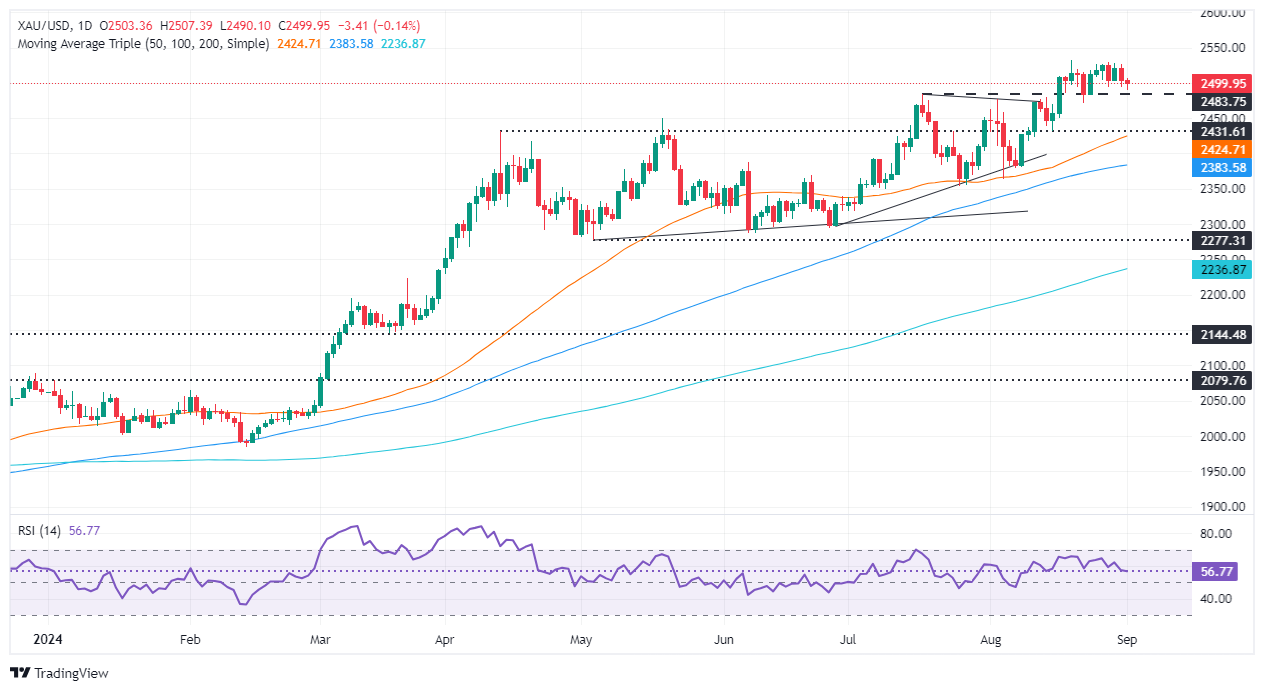Most recent article: Gold edges lower as traders fold arms ahead of labor market data
- Gold prices fall during a quiet North American session with US markets closed for Labor Day.
- Upcoming US economic reports — ISM PMIs, JOLTS job openings, ADP Employment Change, and Nonfarm Payrolls — set to influence Fed rate decision.
- Fed Chair Powell at Jackson Hole noted that inflation was easing but increasing employment risks, raising recession concerns.
- Geopolitical tensions linger as President Biden may propose a ceasefire deal between Israel and Hamas, potentially affecting markets.
Gold prices dipped during the North American session amid thin volumes due to US markets being closed during Labor Day observance. Conversely, the Greenback remains firm as traders brace for a jobs report that could influence the Federal Reserve's decision on the size of September’s rate cut. The XAU/USD trades at $2,499, down by 0.14%.
The US economic docket will be busy this week with the release of the Institute for Supply Management’s (ISM) Manufacturing and Services PMIs, JOLTS job openings, the ADP National Employment Change, and the Nonfarm Payrolls (NFP) figures.
During his speech at Jackson Hole, Federal Reserve Chairman Jerome Powell commented that the risks of inflation are skewed to the downside, while the employment risks are tilted to the upside.
Last Friday, the Fed’s preferred inflation gauge, the Core Personal Consumption Expenditures Price Index (PCE), remained unchanged at around 2.5%, hinting that inflation remains controlled. On the other hand, during the last four NFP reports, the Unemployment Rate has risen from around 3.8% to 4.3%, spurring fears among Fed officials that the labor market could be cooling faster than expected.
That reignited recession fears, which had faded following last week’s solid US data. Initial Jobless Claims fell from their levels in late July, Retail Sales rose sharply, and the economy grew at a 3% pace, according to the second estimate of the second quarter's Gross Domestic Product (GDP) print.
After the data, Bullion prices drooped as investors bought the US Dollar on waning recession fears.
Despite this, geopolitical risks loom even though US President Biden is considering presenting Israel and Hamas a final proposal for a hostage release and ceasefire in Gaza deal later this week, according to Axios sources.
Daily digest market movers: Gold price traders await busy US economic calendar
- ISM Manufacturing PMI for August is expected to improve from 46.8 to 47.8. The Services PMI is estimated to expand from 51.4 to 51.5
- July’s JOLTS job openings are expected at 8.10 million, down from 8.184 million in June.
- Private hiring, revealed by the ADP National Employment Change report, is foreseen increasing from 122K in July to 150K in August.
- August’s NFP figures are expected to rise from 114K to 163K, while the Unemployment Rate could dip, according to the consensus, from 4.3% to 4.2%.
- December 2024 Chicago Board of Trade (CBOT) fed funds future rates contract hints that investors are eyeing 97 basis points of Fed easing this year.
Technical outlook: Gold price set to dive further below $2,500
Gold prices are upwardly biased, though momentum has shifted negatively, as shown by the Relative Strength Index (RSI). Although the RSI is bullish, its slope aims downward, approaching the neutral level. Therefore, in the short term, XAU/USD is downwardly biased.
If XAU/USD drops below $2,500, the next support would be the August 22 low at $2,470. Once surpassed, the next stop would be the confluence of the August 15 swing low and the 50-day Simple Moving Average (SMA) near the $2,424-$2,431 area.
Conversely, if XAU/USD stays above $2,500, the next resistance would be the ATH, and the following resistance would be the $2,550 mark. A breach of the latter will expose $2,600.
Gold FAQs
Gold has played a key role in human’s history as it has been widely used as a store of value and medium of exchange. Currently, apart from its shine and usage for jewelry, the precious metal is widely seen as a safe-haven asset, meaning that it is considered a good investment during turbulent times. Gold is also widely seen as a hedge against inflation and against depreciating currencies as it doesn’t rely on any specific issuer or government.
Central banks are the biggest Gold holders. In their aim to support their currencies in turbulent times, central banks tend to diversify their reserves and buy Gold to improve the perceived strength of the economy and the currency. High Gold reserves can be a source of trust for a country’s solvency. Central banks added 1,136 tonnes of Gold worth around $70 billion to their reserves in 2022, according to data from the World Gold Council. This is the highest yearly purchase since records began. Central banks from emerging economies such as China, India and Turkey are quickly increasing their Gold reserves.
Gold has an inverse correlation with the US Dollar and US Treasuries, which are both major reserve and safe-haven assets. When the Dollar depreciates, Gold tends to rise, enabling investors and central banks to diversify their assets in turbulent times. Gold is also inversely correlated with risk assets. A rally in the stock market tends to weaken Gold price, while sell-offs in riskier markets tend to favor the precious metal.
The price can move due to a wide range of factors. Geopolitical instability or fears of a deep recession can quickly make Gold price escalate due to its safe-haven status. As a yield-less asset, Gold tends to rise with lower interest rates, while higher cost of money usually weighs down on the yellow metal. Still, most moves depend on how the US Dollar (USD) behaves as the asset is priced in dollars (XAU/USD). A strong Dollar tends to keep the price of Gold controlled, whereas a weaker Dollar is likely to push Gold prices up.
Information on these pages contains forward-looking statements that involve risks and uncertainties. Markets and instruments profiled on this page are for informational purposes only and should not in any way come across as a recommendation to buy or sell in these assets. You should do your own thorough research before making any investment decisions. FXStreet does not in any way guarantee that this information is free from mistakes, errors, or material misstatements. It also does not guarantee that this information is of a timely nature. Investing in Open Markets involves a great deal of risk, including the loss of all or a portion of your investment, as well as emotional distress. All risks, losses and costs associated with investing, including total loss of principal, are your responsibility. The views and opinions expressed in this article are those of the authors and do not necessarily reflect the official policy or position of FXStreet nor its advertisers. The author will not be held responsible for information that is found at the end of links posted on this page.
If not otherwise explicitly mentioned in the body of the article, at the time of writing, the author has no position in any stock mentioned in this article and no business relationship with any company mentioned. The author has not received compensation for writing this article, other than from FXStreet.
FXStreet and the author do not provide personalized recommendations. The author makes no representations as to the accuracy, completeness, or suitability of this information. FXStreet and the author will not be liable for any errors, omissions or any losses, injuries or damages arising from this information and its display or use. Errors and omissions excepted.
The author and FXStreet are not registered investment advisors and nothing in this article is intended to be investment advice.
Recommended content
Editors’ Picks

Gold trades near record-high, stays within a touching distance of $3,100
Gold clings to daily gains and trades near the record-high it set above $3,080 earlier in the day. Although the data from the US showed that core PCE inflation rose at a stronger pace than expected in February, it failed to boost the USD.

EUR/USD turns positive above 1.0800
The loss of momentum in the US Dollar allows some recovery in the risk-associated universe on Friday, encouraging EUR/USD to regain the 1.0800 barrier and beyond, or daily tops.

GBP/USD picks up pace and retests 1.2960
GBP/USD now capitalises on the Greenback's knee-jerk and advances to the area of daily peaks in the 1.2960-1.2970 band, helped at the same time by auspicious results from UK Retail Sales.

Donald Trump’s tariff policies set to increase market uncertainty and risk-off sentiment
US President Donald Trump’s tariff policies are expected to escalate market uncertainty and risk-off sentiment, with the Kobeissi Letter’s post on X this week cautioning that while markets may view the April 2 tariffs as the "end of uncertainty," it anticipates increased volatility.

US: Trump's 'Liberation day' – What to expect?
Trump has so far enacted tariff changes that have lifted the trade-weighted average tariff rate on all US imports by around 5.5-6.0%-points. While re-rerouting of trade will decrease the effectiveness of tariffs over time, the current level is already close to the highest since the second world war.

The Best brokers to trade EUR/USD
SPONSORED Discover the top brokers for trading EUR/USD in 2025. Our list features brokers with competitive spreads, fast execution, and powerful platforms. Whether you're a beginner or an expert, find the right partner to navigate the dynamic Forex market.
